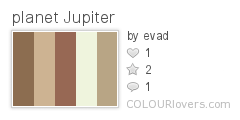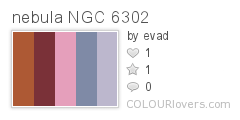The Hubble telescope is back online after undergoing a billion dollar repair mission earlier this year. After installing two new cameras, other science instruments and replacing broken parts, Hubble is returning the sharpest and most colorful images the Earth has ever seen.
To create your own Hubble inspired palettes using PHOTOCOPA simply click on the image. To see palettes other users have created based on the image click on the palette.
These two images of a huge pillar of star birth demonstrate how observations taken in visible and in infrared light by NASA’s Hubble Space Telescope reveal dramatically different and complementary views of an object.
The pictures demonstrate one example of the broad wavelength range of the new Wide Field Camera 3 (WFC3) aboard the Hubble telescope, extending from ultraviolet to visible to infrared light.
Composed of gas and dust, the pillar resides in a tempestuous stellar nursery called the Carina Nebula, located 7,500 light-years away in the southern constellation Carina. The pair of images shows that astronomers are given a much more complete view of the pillar and its contents when distinct details not seen at visible wavelengths are uncovered in near-infrared light.
A clash among members of a famous galaxy quintet reveals an assortment of stars across a wide color range, from young, blue stars to aging, red stars.
An image taken by the refurbished Hubble Space Telescope, shows the planet Jupiter. Image released by NASA on Wednesday, Sept. 9.


This image of barred spiral galaxy NGC 6217 is the first image of a celestial object taken with the newly repaired Advanced Camera for Surveys (ACS) aboard the Hubble Space Telescope. The camera was restored to operation during the STS-125 servicing mission in May to upgrade Hubble.
NASA’s Hubble Space Telescope snapped this panoramic view of a colorful assortment of 100,000 stars residing in the crowded core of a giant star cluster.
The image reveals a small region inside the massive globular cluster Omega Centauri, which boasts nearly 10 million stars. Globular clusters, ancient swarms of stars united by gravity, are the homesteaders of our Milky Way galaxy.
The stars in Omega Centauri are between 10 billion and 12 billion years old. The cluster lies about 16,000 light-years from Earth.
This image shows the planetary nebula, catalogued as NGC 6302, but more popularly called the Bug Nebula or the Butterfly Nebula. The Wide Field Camera 3 (WFC3), a new camera aboard NASA’s Hubble Space Telescope was installed by NASA astronauts in May 2009, during the servicing mission to upgrade and repair the 19-year-old Hubble telescope. NGC 6302 lies within our Milky Way galaxy, roughly 3,800 light-years away in the constellation Scorpius. The glowing gas is the star’s outer layers, expelled over about 2,200 years. The “butterfly” stretches for more than two light-years, which is about half the distance from the Sun to the nearest star, Alpha Centauri. Image released by NASA on Wednesday, Sept. 9. NASA
The Hubble Space Telescope’s newly repaired Advanced Camera for Surveys (ACS) has peered nearly 5 billion light-years away to resolve intricate details in the galaxy cluster Abell 370.
Abell 370 is one of the very first galaxy clusters where astronomers observed the phenomenon of gravitational lensing, where the warping of space by the cluster’s gravitational field distorts the light from galaxies lying far behind it. This is manifested as arcs and streaks in the picture, which are the stretched images of background galaxies.











